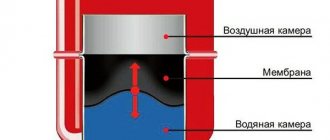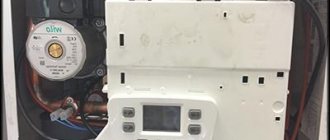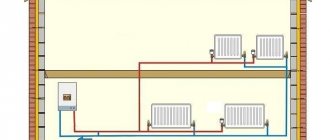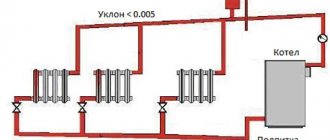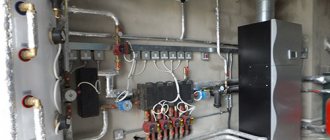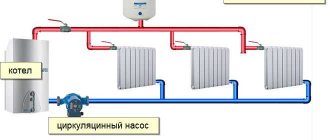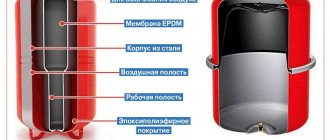Most residential apartment buildings and private houses are equipped with a water heating system. In order for it to function without failures, it is necessary to carefully consider the layout and operation of it. It is known that when water heats up, it tends to expand, and to prevent overloading the system, an expansion tank is used. We will tell you how to make a high-quality pressure stabilizer with your own hands - an open/closed expansion tank. We also suggest that you familiarize yourself with the photo selection presented in the material.
Expansion tanks in various heating systems
In any building, be it administrative or residential, the heating system can be represented by one of the following options: centralized, autonomous open/closed type.
Let's take a closer look at the design features of the expansion tank for the most common systems, as well as the functions it performs.
Centralized system . The expansion tank is a sealed container, at the top of which there is a valve designed to release excess air.
Attention. The Mayevsky valve should not be used due to its small bore diameter, which can lead to excessively long bleeding of air from the heating system.
The tank is mounted at the highest point of the upper spill of the heating system. During its operation, air tends precisely there, displaced by a heat source moving downwards. The system is started in the basement by opening the circuit valves and bleeding air from the tank.
Autonomous open system. Everything in this system is quite simple. The expansion tank is a non-hermetic structure, closed with a lid to prevent dust, etc. from getting inside. The movement of coolant through an open heating system is possible due to convection. In this case, the heat source comes into contact with the air directly in the expansion tank, which, in turn, performs 2 functions: it compensates for the expansion of the coolant and at the same time is the highest point of the circuit into which the bleed air enters.
Autonomous open system
Autonomous closed system. In such a system, the tank is represented by a container divided into two parts by a special rubber membrane. One part of the tank contains air. In the other - liquid from the system. This design prevents the accumulation of air (enriched with oxygen) in the heating system, which destroys pipes and radiators.
The coolant circulates through the heating system under the action of a circulation pump. The heating circuit in this case has no contact with the environment, and the tank is just a container with a reserve volume, thanks to which the coolant is able to expand during operation of the heating system.
Autonomous closed system
Purpose of heating expansion tanks
Gravity heating system with an open expansion tank
Before considering expansion tanks for the heating system, you need to find out their purpose. It is associated with the property of water or a similar coolant to expand under the influence of temperature. As a result, the pressure in the system increases. Its excess must be compensated.
Using an air vent or similar shut-off valves is effective, but has certain negative aspects. The main one is the release of water from the system, as a result of which there is a high probability of the formation of air locks. But how does the expansion tank work in the heating system when excess pressure occurs? Let's look at the general operating principle using the simplest open model as an example:
- In normal condition, the closed expansion tank is 2/3 full;
- As the volume of coolant increases, the filling level of the container increases, thereby stabilizing the system;
- As soon as the water temperature drops to the optimal level, its volume in the system will decrease to normal;
- At the same time, the coolant level in the tank stabilizes.
Closed models work on the same principle. The difference lies in the design - it is divided into 2 chambers. The first is connected to the heating main and filled with water, and in the second a pressure equal to normal for this system is created. Moreover, both chambers are separated by an elastic membrane. As soon as the volume of coolant in the pipes exceeds the critical one, the pressure in the heating expansion tank compensates for this process by displacing the membrane. In this way, the actual heating volume is temporarily increased.
For a system with forced circulation, it is prohibited to install an open type expansion tank. It will not be able to provide the required tightness.
Making an expansion tank with your own hands
It is quite possible to make an expansion tank yourself. To do this, you only need a set of certain tools and materials, diligence and care.
List of required materials and tools
To create an expansion tank, the following tools and working materials are required:
- welding machine;
- locksmith tools;
- electrodes;
- Oil paint;
- metal to create a tank capacity;
- brass stopper;
- welding mask;
- rubber gaskets;
- pipes with a cross section of 200-300 mm.
Design creation process
First of all, it is worth mentioning one point. At home, it is advisable to manufacture an expansion tank only for an open-type heating system. This is due, first of all, to the fact that for a tank with a membrane, just choosing the optimally suitable membrane and inserting a nipple will take a lot of effort, time and money.
So, to create the structure we need sheet metal and pipe cuttings. Then we cook a regular rectangular/square box.
Advice. Many experts advise using stainless steel as a working material for an expansion tank for heating. This is good advice, but only if the entire heating system (pipes) is made of stainless steel or polymers. In other cases, ordinary “black” steel with a thickness of at least 3 mm is quite suitable.
First you need to decide on the volume of the future expansion tank. The standard indicator is 10% of the total amount of coolant in the heating system.
Let's get to work. Using a grinder, we make five steel blanks for the future container. Then we weld them vertically to each other with a continuous seam. Then all that remains is to cut a hole in the bottom of the tank and the rough structure is ready.
Advice. A varnish/paint container or a truck fuel tank is also perfect for making a tank (do not consider a tank from a car, as it is usually too thin.
Let's start cleaning the inner surface of any remaining flammable mixture: hot water and a brush are suitable for this purpose. After cleaning is complete, leave the container to dry. We prepare a lid for the tank and fasten it with bolts or make a hatch.
After completing work with the lid, we make a steel blank for the fitting and weld it into the tank. Be sure to use a brass plug (do not forget to line it with a rubber gasket about 0.5 cm thick). Be sure to lubricate the fitting thread with a layer of fat or oil to facilitate the process of unscrewing it in the future.
Making a Tank
We cover the finished tank with oil paint on all sides (inside if possible).
Since the expansion tank will be located in the attic of the house, it must be properly insulated to prevent the possibility of freezing of the liquid inside it.
The nuances of making an open tank yourself
Open expansion tanks for heating, instructions for which are provided by the manufacturer at the time of purchase, can be made independently. It is worth understanding that an open expansion tank in a heating system can be used in systems with natural and forced circulation of coolant. Having decided to make an open expansion tank for heating with your own hands, the owner must choose the product format. In particular, the tank may have a rectangular or cylindrical shape.
A simpler manufacturing process involves choosing a rectangular tank. Such a device can be used for systems with a large volume of coolant, since the design of the tank allows the installation of additional reinforcements on the outer walls.
To carry out the work, the owner will need certain equipment:
- roulette;
- Bulgarian;
- welding machine;
- consumables (medium-thick stainless steel sheet or other durable metal, as well as pipes);
- schematic illustration of the tank with dimensions.
If all the necessary materials and tools are available, the owner can begin work. First, he will need to mark the sheet metal and, using a grinder and a cutting wheel, cut out blanks for the tank from it. At this stage, you should act consistently and slowly - it is important not to forget about the need to clean the edges of each workpiece and carry out the work carefully.
After all the workpieces are prepared, you can begin welding work. In addition to connecting the five main blanks that form the walls of an open rectangular tank, at this stage the owner can weld the mount for the heating expansion tank, with which the element will be attached at the top point of the circuit.
At the bottom of the prepared tank, it is necessary to make a hole, the diameter of which corresponds to the internal cross-section of the pipe connecting the expansion tank to the heating circuit. The pipe can be welded to the tank or secured with a flange connection, guaranteeing strength and reliability.
As a rule, the tank is installed in the attic or attic. To prevent the unheated installation location of the expansion tank in the heating system from causing water to freeze, the tank should be insulated. It is recommended to insulate the tank using non-flammable modern insulation materials. At this point, the process of making a tank yourself can be considered complete.
Useful tips from professionals
Finally, we suggest you familiarize yourself with some practical tips that may help prevent certain errors from occurring in your workflow:
- As you might have guessed, the actual volume of the expansion tank is calculated according to a complex formula and, if you are not an expert, then you should not be too zealous and delve into the numbers - take as a basis the standard indicator of 10% of the total coolant volume.
- If, during the operation of a self-made expansion tank in the heating system, the safety valve is triggered too often, this indicates that the volume of the tank was calculated incorrectly. And this, in turn, means that you made a mistake in calculating the total volume of coolant in the system. The solution in this situation is very simple: add another expansion tank to the system, which will compensate for the missing volume.
- In order for the piping to be installed correctly, special attention should be paid to only two places in the system: the place where the coolant enters the expansion tank (should be done at the top point) and the place where it leaves (carried out from the bottom).
- To avoid boiling of the liquid in the expansion tank, take care of two things: the correctly selected diameter of the circuit pipes and the presence of a slope of the circuits.
We have provided you with general information about expansion tanks in the heating system, and also provided instructions for making an effective design with your own hands. We wish you good luck!
Calculation of the physical dimensions of the device
In order for the expansion tank of the heating system to correctly perform the tasks assigned to it, the owner must make sure that this element corresponds to the design parameters. The calculation of the tank can be made with the involvement of heating specialists who will take into account all the operating parameters of the system and provide their verdict on which expansion tank is needed to heat a particular building. But the homeowner can make the necessary calculations himself.
To find out which expansion tank for heating should be installed in the system, the owner needs to have information regarding the following parameters:
- total volume of water in the circuit;
- nominal pressure;
- range of temperature conditions of the circuit.
Next, you need to calculate the volume that water creates when heated. This can be done based on the following information - when heated from 20 to 80 degrees, the coolant expands by 5%. In addition to this five percent, another five percent is added for reserve.
Installing an expansion tank in the heating system must compensate for expansion equivalent to the volume of a tenth of the water in the circuit.
Knowing how much expansion tank volume is needed for heating, the owner can easily determine its physical dimensions.
Expansion tank for heating: photo
DIY expansion tank for heating from a canister
Home / Communications / Heating / Do-it-yourself expansion tank for heating from a canister
In individual heating systems, an expansion tank .
The main task pursued during installation is to compensate for changes in the volume of liquid when heated.
In fact, pipelines and heating devices change the internal volume filled with coolant slightly when the temperature changes. Water is often used as a coolant in heating systems, which, when heated to a temperature of 90–95 °C, can increase the volume by 2.5–2.8%.
Attention! Excess liquid volume is directed into a special container, which is located highest in the heating system.
Another problem that is solved when installing an expansion tank is that the presence of such a container allows you to fill the system with coolant .
In order for the flow of liquid to circulate through pipelines and heating devices, the condition of flow continuity is observed ( Daniil Bernoulli wrote about it in the mid-18th century ).
The continuity of the flow is the absence of places where there is no water. The presence of voids will create a condition in which the existing gas bubbles will not allow the movement of liquid.
A similar phenomenon is observed during the initial period of the heating season; air pockets , which are removed by filling the system with water. Excess liquid is located on top in a special container.
Reference! Natural circulation inside a closed space is possible only if there is a certain hydrostatic head (Hst). The higher the Hst value, the more intense the coolant circulation.
As the temperature of the coolant decreases, the volume decreases . Some of the water from the expansion tank is returned to the heating system.
Heating systems are made with natural and forced circulation of coolant.
open- expansion tanks are used .
In cases where the coolant is stimulated to move with the help of special circulation pumps, closed- type expansion devices are more often used.
An open type expansion tank is a regular metal box connected to a pipe from the heating main. It is placed in the highest accessible place of the building (house).
During the heating season, the presence of water in the tank is regularly checked. If necessary, add liquid to the expansion tank.
Some experts install a float level control system in the expansion tank. When the level drops, the float lowers, which leads to the opening of the feed tap.
The water is automatically added to the required level. Automatic systems are installed only where there is a water supply system in which a pressure exceeding the hydrostatic value Hst .
- An extremely simple device, easy to make with your own hands.
- It can function for years without causing any complaints from users.
- Corrosion damages the expansion tank first.
- It is necessary to regularly monitor the presence of fluid and top up if necessary . Often in private homes, when installing a heating system, the tank for expansion of the coolant is the last thing that is remembered. I place it near the ceiling, which creates inconvenience when refilling. Forced to use flat bottles to add water.
- It is necessary to lay an additional pipe , which will heat only the space near the ceiling.
Important! The coolant tends to evaporate. It needs to be topped up periodically to prevent air pockets from forming inside the heating system.
In such tanks there are two volumes separated from each other by a movable membrane . The lower space contains coolant, and the upper space contains ordinary air.
To create pre-pressure in the system, a valve and fitting . By connecting a pump, you can increase the pressure inside the air chamber.
Using a pressure gauge, the set pressure in the heating system Nst is controlled and set.
Installation of such a device is carried out in different parts of the heating system, most often traditionally installed near the boiler on the supply line.
Some users install additional taps and pressure gauges to know the pressure value during operation.
Positive indicators of a closed system:
- There is no need to constantly monitor the coolant level in the system; after filling it once, you won’t have to worry about it being full for several years.
- Non-freezing liquids (high-boiling alcohols) are added to the coolant, which are not afraid of temperature drops below 0 ° C , which is important for country houses that are visited only periodically.
- There is no metal corrosion , since air does not enter inside.
The minus is conditional. It is necessary to equip a closed heating system with control devices, as well as a safety valve , which will open in the event of a sudden increase in pressure.
Attention! A sharp increase in pressure in the coolant is only possible if its circulation stops . This can happen if the circulation pump is damaged or disconnected.
There is one more drawback that manufacturers of closed tanks do not want to talk about. The membrane loses its elasticity over time . If the pressure changes inside, damage will occur. That's why collapsible tanks are available on sale. It is easy to replace the membrane in them after a certain time. Typically, such maintenance is done in the summer, in preparation for the new heating season.
You should begin work by creating a drawing or sketch of the future product. At the same time, the materials and tools available to the home craftsman for making the expansion tank are evaluated.

